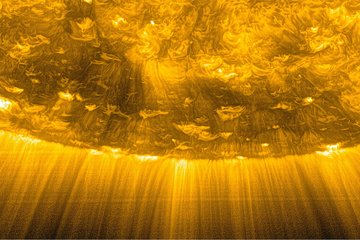All genres
1.
Journal Article
Observations indicating that ≈ 1 × 107 K solar flare plasmas may be produced in situ from ≈ 1 × 106 K coronal plasma. Astrophysical Journal 609, pp. 439 - 451 (2004)
2.
Journal Article
Doppler oscillations of active region loops: steps towards coronal seismology. Hvar. Obs. Bull. 27 (1), pp. 83 - 90 (2003)
3.
Journal Article
Spectroscopy of solar prominences from space and ground. Astron. Nachrichten 324 (4), pp. 338 - 339 (2003)
4.
Journal Article
Free-free emission in the far-ultraviolet spectral range: A resource for diagnosing solar and stellar flare plasmas. Astrophysical Journal 593, pp. 1226 - 1241 (2003)
5.
Journal Article
Spectroscopy of solar prominences simultaneously from space and ground. Solar Physics 217, pp. 133 - 155 (2003)
6.
Journal Article
Hot coronal loop oscillations observed with SUMER: Examples and statistics. Astronomy and Astrophysics 406, pp. 1105 - 1121 (2003)
7.
Journal Article
SUMER observations of solar transition region structures and dynamics. Advances in Space Research 30 (3), pp. 495 - 500 (2002)
8.
Journal Article
Correlated dynamics of hot and cool plasmas in the main phase of a solar flare. Astrophysical Journal 568, pp. L61 - L65 (2002)
9.
Journal Article
Doppler shift oscillations of hot solar coronal plasma seen by SUMER: A signature of loop oscillations? Astrophysical Journal 574, pp. L101 - L104 (2002)
10.
Journal Article
Transition region and coronal plamas: Instrumentation and spectral analysis. Astrophysics and Space Science 282, pp. 189 - 207 (2002)
11.
Journal Article
Observations of ultraviolet emission lines in solar coronal holes on the disk with SUMER on SOHO. Advances in Space Research 30 (3), pp. 517 - 522 (2002)
12.
Journal Article
On the unresolved fine structure of the solar atmosphere. IV. The interface with the chromosphere. Astrophysical Journal 558, pp. 423 - 427 (2001)
13.
Journal Article
A multi-wavelength study of solar coronal-hole regions showing radio enhancements. Astronomy and Astrophysics 378, pp. 1037 - 1045 (2001)
14.
Journal Article
The morphology of the solar upper atmosphere during the sunspot minimum. Space Science Reviews 93, pp. 411 - 472 (2000)
15.
Journal Article
Die Quellen des schnellen Sonnenwindes. Physikalische Blätter 56, pp. 51 - 53 (2000)
16.
Journal Article
On the source regions of the fast solar wind in polar coronal holes. Astronomy and Astrophysics 353, pp. 749 - 756 (2000)
17.
Journal Article
Solar irradiances of ultraviolet emission lines measured during the minimum of sunspot activity in 1996 and 1997. Physics and Chemistry of the Earth C, 25, pp. 389 - 392 (2000)
18.
Journal Article
Solar spectroradiometry with the telescope and spectrograph SUMER on the Solar and Heliospheric Observatory SOHO. Metrologia 37, pp. 393 - 398 (2000)
19.
Journal Article
Statistical Analysis of EUV Lines Inside and Outside of Solar Coronal Holes. Space Science Reviews 87, pp. 161 - 164 (1999)
20.
Journal Article
The Ne VIII (λ770) resonance line: Solar wavelengths determined by SUMER on SOHO. Astronomy and Astrophysics 346, pp. 285 - 294 (1999)










